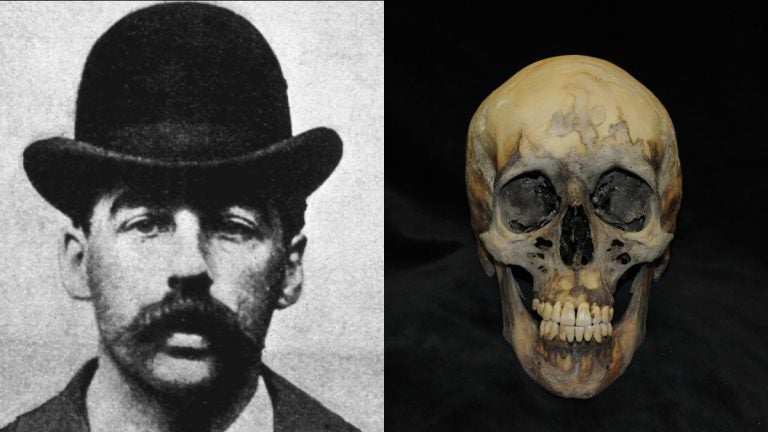Penn scientists dig up evidence to settle questions about H.H. Holmes — first American serial killer
Listen
Serial killer H. H. Holmes is depicted in an 1895 photo beside the skull exhumed from his grave at Holy Cross Cemetery in Yeadon. (Wikimedia Commons and Penn Museum)
The museum of the University of Pennsylvania has been investigating the remains of America’s first serial killer. In May, anthropologists with the museum exhumed the remains of H.H. Holmes from Holy Cross Cemetery in Yeadon, Delaware County.
In the late 19th century, H.H. Holmes was the proprietor of a hotel in Chicago around the time of the 1893 World’s Fair. He renovated the building to make it easier to surreptitiously kill his guests and dispose of their bodies through the basement. At his “Murder Castle,” he is believed to have killed more than 200 people.
Fleeing Chicago and a trail of debts, he was eventually caught in Philadelphia. Holmes was tried, executed, and buried in Holy Cross Cemetery in Yeadon.
Earlier this year, the History Channel produced an eight-part series about Holmes, “American Ripper.” In it, a descendant of Holmes and a former CIA researcher team up to make a case that Holmes may have traveled to London to do the Jack the Ripper killings.
They also investigated the possibility that Holmes may have evaded his own execution by having somebody stand in for him at the gallows.
After obtaining permission from the state of Pennsylvania to exhume the remains, the History Channel team found a coffin filled with concrete, with no body.
Standing in the grave pit, they drilled through the floor of the coffin and discovered another coffin underneath — also filled with concrete. Encased inside the slab was a body.
“The more questions you ask, the weirder this story gets,” said Penn anthropologist Samantha Cox, who was asked by the History Channel to do the forensic science.
The body of H.H. Holmes — spoiler alert: it is his body — was encased in concrete and buried below the water table at his own request. His body rotted, but due to the anaerobic environment inside a chamber of water-filled concrete, it had not properly decomposed after 120 years.
So when Cox opened the hidden coffin, the clothes were almost perfectly preserved, and his skull retained its moustache. But all the body tissue was basically a puddle that had to be pumped out.
“It stank,” said Cox. “Once it gets to that point we can’t do anything with it. We can’t test it, can’t get any DNA out of it. It’s really kind of sludge.”
The bones survived, as well as Holmes’ teeth. With them Cox was able to answer the questions the History Channel was asking. This was, indeed, Holmes.
“They were really great. There was never a time they tried to get us to say something we didn’t want to say, or trying to lead us to an answer,” she said. “This is one of those cases where the truth was stranger than fiction. If they wanted to make this up, people would have said this is too wacky.”
More than sensational and gruesome, Cox said, the remains of H.H. Holmes can add to the field of forensic science. Because of laws regulating the handling of human remains, it’s rare for anthropologists to have newly discovered 19th century material to work with.
Rarer still is the opportunity to examine physical remains of a 19th century person who was so well documented by police, courts, and the press.
“He’s a known person. We know things about him,” said Cox. “Comparing his story to his remains — and putting the whole thing together — is the academic part of this.”
The final episode of the H.H. Holmes investigation aired on Tuesday evening. It’s now available on the History Channel’s website. On Thursday evening, Cox and a panel of Penn researchers will present “Science of a Psychopath: Identifying the American Ripper,” a scientific profile of H.H. Holmes at a public event at the museum.
WHYY is your source for fact-based, in-depth journalism and information. As a nonprofit organization, we rely on financial support from readers like you. Please give today.





